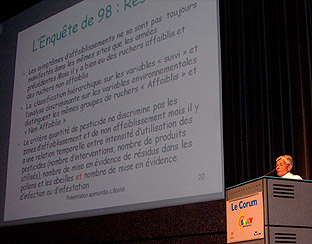|
A TOOL TO DETERMINE THE AFRICANIZATION OF AN APIARY
Tiago M. Francoy
tiago.francoy@gmail.com
San Pablo - Brasil

"Identification of Africanized bees by wing morphometry: two fast and efficient procedures ", this is the title of the original work published in the magazine "Apidologie". It is about a tool and a methodology accesible to many queen breeder as well as to many amateurs interested in knowing better what bee race they are working with. But it also seems appropiate spread it because it can constitute a tool that facilitates the selection of non-africanized material, suitable to be exported to those countries that forbid the entering of living material without the corresponding certificate of free of africanization. We aspire, as the author suggests, that this methodology is internationally approved. Meanwhile, we consider it a selection tool previous to the DNA studies. Together with the work (SUMMARY - INTRODUCTION - MATERIALS AND METHODS - DISCUSSION - CONCLUSSIONS AND BIBLIOGRAPHY), we present the morphometric diferenciation of Apis mellifera mellifera and Apis mellifera carnica that Friedrich Ruttner conducted, and the parameters set by the italian legislation for Apis mellifera ligustica and Apis mellifera sicula. Finally, the work includes the methodology of processing the digital immages and the tables of identification the different species based on computarized statistical analysis, that nowadays can be conducted in any personal computer with free access software.
To top
BEEKEPING AND PESTICIDES: THE FRENCH EXPERIENCE
Jean Sabench, Cécile Fléché, Janine Kievitz
Montpellier, France

Cécile Fléché (picture), former director of AFSSA (French Food Safety Agency) said "it is necessary to eliminate the use of pesticides because they are the main risk factor to the dissappearance of the bee". "Bee Intoxication with Pesticides" was the title of the second roundtable during the recent Congress of Apimondia in Montpellier, France. It was coordinated by Janine Kievitz, from CARI (Beekeeping Centre of Research and Information - Belgium) with the participation of some important international representatives that, not only have access to scientific and technical information, but they also promote, develp and stand up for it in different areas. The pressures and tacit agreements among governments and laboratories are seen as a constant around the globe. Where the differences are regrettable is between the societies and those who claim to represent them. Jean Sabench, president of the commission about pesticides of the "Confédération Paysanne" (French Beekeepers Union) made a revision about the dysfunction of the State and its submission to the lobbyist, which was entitled: Bees are also dying for the government's fault. This is the beginning of the analysis of the more relevant aspects presented in the papers on strategies of beekeepers, States and laboratories before the environmental problem caused by the pesticides.
To top
|
41st APIMONDIA CONGRESS
Fernando Esteban

41st Apimondia Congress took place in Montpellier, France with an exceptional quantity of visitors. The National Union of French Beekeeping (UNAF) successfully completed its leadership in the defense of beekeeping and bess worlwide. In total agreement with its history and the judicial sentencing to "Gaucho" of Bayer 10 years ago, "The bee: sentinel of the environment" was a true and legitimate motto for most delegations and not just a mere opportunist slogan. In more than 10 full colour pages, we analyze deeply the context in which the Congress took place, the commercial, technician novelties; the projection of beekeeping and the market of its products.
To top
PESTICIDES-COATED SEEDS: GERMAN BEEKEEPERS
Walter Haefeker - EPBA

Some bees collecting pesticida powder and taking it as poller to the brood nest. Picture Walter Haefeker
The sanction of the French Courts banning the use of "Gaucho" with Imidacloprid was initially considered by many people just like another rejection of the French to the German Laboratory Bayer. When the mortality of beehives worsened in the whole Europe, the banning started in Italy, Greece and in Germany itself. The arguments that German beekeepers had to present to face Bayer Crop Science in their own country, as well as the teachings they leave us, were exhibited in Apimondia Congress by the president of the European Proffesional Beekeepers Associacion (EPBA) Walter Haefeker. It is necessary to spread this publication regarding the imminent sowing for the heavy crop in South America and the risks it implies to beekeeping. The article describe what Walter called "Loss of beehives in Germany: report and lesson learned", at the same time, it also includes a summary of the recent work of Vicenzo Girolami, published by the "Entomological Society of America", called "Translocation of Neonicotinoid Insecticides from Coated Seed to Seedling Guttation Drops: A Novel Way of Intoxication for Bees".
To top
NOSEMA DISEASE: SURVEYS IN CORDOBA
Enrique Sosa
Córdoba, Argentina
The teachers of the chair of "farm" from the Faculty of Agricultural Sciences from National University of Córdoba conducted a survey that, at the beginning, confirms the tendency of a direct relation between the quantity of humidity in the air, depending on the region, and the development of nosema disease. The first results were exposed during the XVIIth Fair and Beekeeping Meetings from the Centre of the Country, that took place in Río Cuarto during last May 2009. Said teachers wrote this article in which it is also developed the general perspective of the activity. The article shows the behaviour and evolution of Nosema in two well differenciated areas, regarding weather and phytogeography: Ischilín deparment and San Justo deparment, both located in the province of Córdoba, Argentina.
To top
| 
 ARGENTINE BEEKEEPING MAGAZINE
ARGENTINE BEEKEEPING MAGAZINE



 inform@apicultura.com.ar
inform@apicultura.com.ar